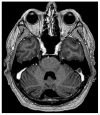Trigeminal Pontine Sign: From Imaging to Diseases Beyond Trigeminal Neuralgia
- PMID: 39727657
- PMCID: PMC11726984
- DOI: 10.3390/diseases12120327
Trigeminal Pontine Sign: From Imaging to Diseases Beyond Trigeminal Neuralgia
Abstract
The so-called trigeminal pontine sign has been described as a marker of different diseases, from multiple sclerosis to herpetic infections. First, it has been proposed as linear hyperintensity in the pons on the Magnetic Resonance Imaging (MRI) of patients with multiple sclerosis and trigeminal neuralgia. After these descriptions, it has been reported as incidental findings in the same patients and in patients with HSV or VZV infections. In addition, patients with neuromyelitis optica spectrum disorders (NMOSD) have been more rarely described with this neuroradiological sign. In this review, the main anatomical and neuroradiological issues underlying the trigeminal pontine sign are described, together with the limitations of the published studies from the clinical and neuroimaging point of view. Finally, the association with different diseases is detailed.
Keywords: MRI; NMOSD; VZV; multiple sclerosis; trigeminal nerve; trigeminal pontine sign.
Conflict of interest statement
The authors declare no conflicts of interest.
Figures





Similar articles
-
Differentiating multiple sclerosis and neuromyelitis optica spectrum disorders through pontine trigeminal nerve lesions: A comparative MRI study.Eur J Radiol. 2024 Sep;178:111597. doi: 10.1016/j.ejrad.2024.111597. Epub 2024 Jul 1. Eur J Radiol. 2024. PMID: 38996736
-
Can pontine trigeminal T2-hyperintensity suggest herpetic etiology of trigeminal neuralgia?Quant Imaging Med Surg. 2016 Oct;6(5):490-495. doi: 10.21037/qims.2016.01.07. Quant Imaging Med Surg. 2016. PMID: 27942467 Free PMC article.
-
Trigeminal root entry zone involvement in neuromyelitis optica and multiple sclerosis.J Neurol Sci. 2015 Aug 15;355(1-2):147-9. doi: 10.1016/j.jns.2015.06.004. Epub 2015 Jun 3. J Neurol Sci. 2015. PMID: 26055314
-
Trigeminal neuralgia secondary to multiple sclerosis: from the clinical picture to the treatment options.J Headache Pain. 2019 Feb 19;20(1):20. doi: 10.1186/s10194-019-0969-0. J Headache Pain. 2019. PMID: 30782116 Free PMC article. Review.
-
Symptomatic trigeminal autonomic cephalalgias in neuromyelitis optica spectrum disorders.Mult Scler Relat Disord. 2023 Jun;74:104722. doi: 10.1016/j.msard.2023.104722. Epub 2023 Apr 20. Mult Scler Relat Disord. 2023. PMID: 37105088 Review.
References
-
- Laine F.J., Smoker W. Anatomy of the cranial nerves. Neuroimaging Clin. N. Am. 1998;8:69–100. - PubMed
Publication types
LinkOut - more resources
Full Text Sources

